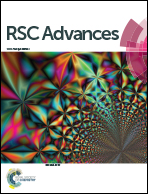Carbon quantum dots decorated leaf-like CuO nanosheets and their improved dispersion for an excellent UV-shielding properties in polymer films†
Abstract
We report a simple method for synthesizing carbon quantum dot (CQD) decorated leaf-like CuO nanosheets. The CQDs not only relay to improve the dispersion of CuO but also offer higher UV-shielding properties. Excellent UV-shielding properties were witnessed in a polymer film containing 0.5 wt% of CQD/CuO nanocomposites.


 Please wait while we load your content...
Please wait while we load your content...